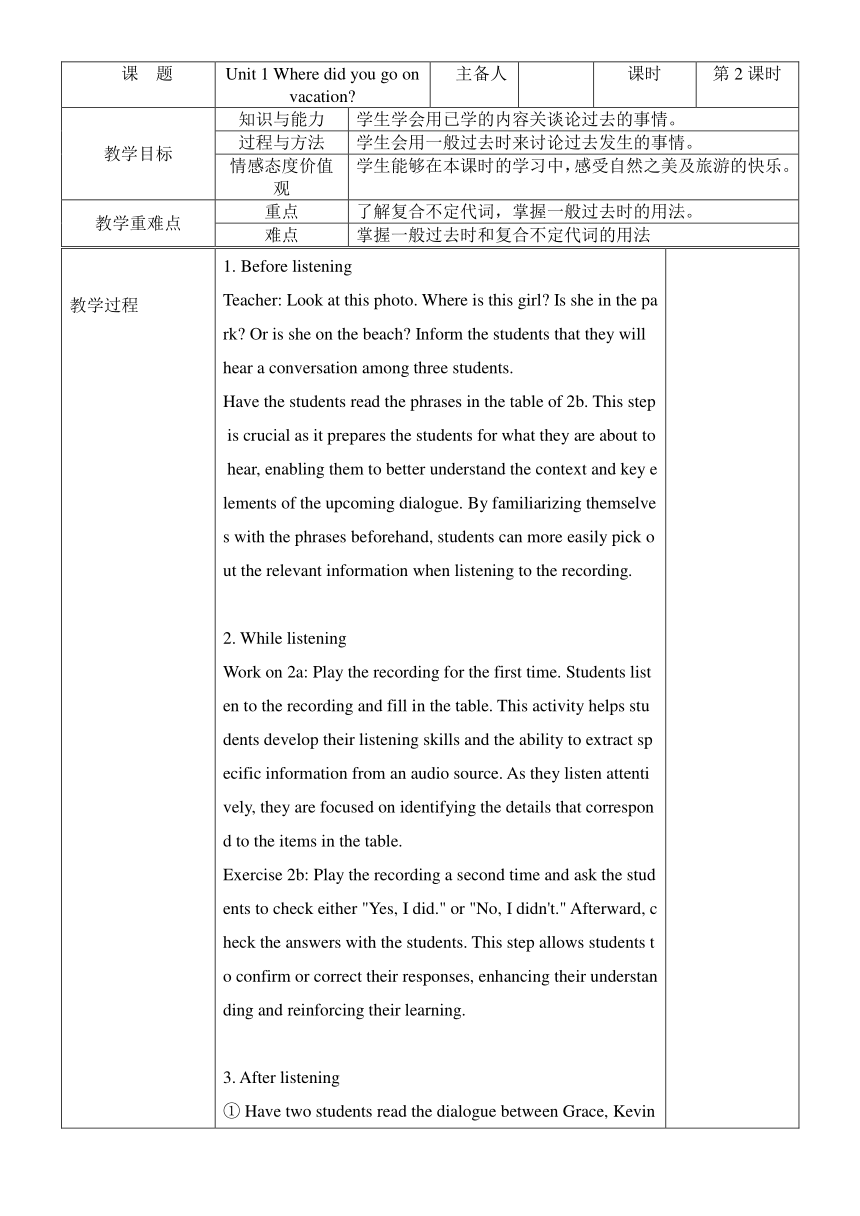
课 题 Unit 1 Where did you go on vacation 主备人 课时 第2课时 教学目标 知识与能力 学生学会用已学的内容关谈论过去的事情。 过程与方法 学生会用一般过去时来讨论过去发生的事情。 情感态度价值观 学生能够在本课时的学习中,感受自然之美及旅游的快乐。 教学重难点 重点 了解复合不定代词,掌握一般过去时的用法。 难点 掌握一般过去时和复合不定代词的用法 教学过程 Before listening Teacher: Look at this photo. Where is this girl Is she in the park Or is she on the beach Inform the students that they will hear a conversation among three students. Have the students read the phrases in the table of 2b. This step is crucial as it prepares the students for what they are about to hear, enabling them to better understand the context and key elements of the upcoming dialogue. By familiarizing themselves with the phrases beforehand, students can more easily pick out the relevant information when listening to the recording. 2. While listening Work on 2a: Play the recording for the first time. Students listen to the recording and fill in the table. This activity helps students develop their listening skills and the ability to extract specific information from an audio source. As they listen attentively, they are focused on identifying the details that correspond to the items in the table. Exercise 2b: Play the recording a second time and ask the students to check either "Yes, I did." or "No, I didn't." Afterward, check the answers with the students. This step allows students to confirm or correct their responses, enhancing their understanding and reinforcing their learning. 3. After listening ① Have two students read the dialogue between Grace, Kevin, and Julie. This gives students an opportunity to hear the dialogue read aloud with proper intonation and pronunciation, further enhancing their understanding of the language and conversation flow. ② Ask the students to work in pairs and try to act out the roles in the dialogue. This activity encourages active participation and collaboration among students. It also helps them practice speaking and using the language in a meaningful context. ③ Have several pairs perform their dialogues in front of the class. This not only showcases the students' efforts but also provides an opportunity for others to learn from their peers and gain additional insights. 4. Role-play (1) First, have the students read the dialogue and match the people with the places they went. This initial step helps students understand the relationships between the characters and the locations, setting the stage for a more comprehensive understanding of the dialogue. (2) Listen to the recording again and complete the dialogue. This activity builds on the previous step by having students fill in the missing parts of the dialogue, further enhancing their listening and comprehension skills. (3) Read the dialogue and answer the questions. This prompts students to analyze the dialogue more deeply and develop their critical thinking skills as they respond to the question ... ...
~~ 您好,已阅读到文档的结尾了 ~~

